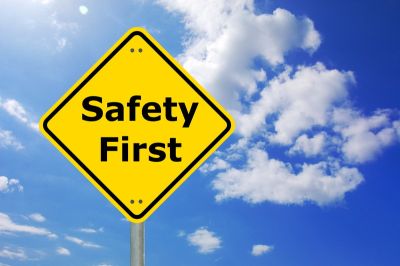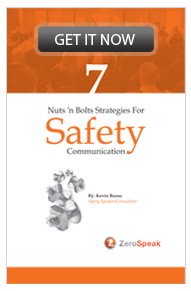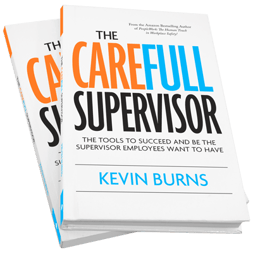To resonate, a safety message needs to address perceptions, misconceptions and align with attitudes.
 Safety communications and marketing are important. A cohesive communications or safety marketing strategy helps to connect many of the dots in safety for your people. It gives them reminders and helps safety stay top-of-mind. Telling your people something once in a safety meeting and hoping that it changes behaviour doesn't work. It won’t. You need to include a communications and safety marketing strategy. Then repeat.
Safety communications and marketing are important. A cohesive communications or safety marketing strategy helps to connect many of the dots in safety for your people. It gives them reminders and helps safety stay top-of-mind. Telling your people something once in a safety meeting and hoping that it changes behaviour doesn't work. It won’t. You need to include a communications and safety marketing strategy. Then repeat.
To impact people to make changes, or to increase focus on safety, you have to create a series of repetitive reminders. Why do you think fast food restaurants advertise so much? We all get hungry and have to eat at some point during the day. But there are a lot of choices. Where we eat can be influenced by the number of times we are exposed to a message. Repetition of a message moves people to take action. But it has to be the right message. Generic safety messages mostly miss the mark.
Do a Google images search using “Safety First” as the search term. Now lay witness to the thousands of images and posters with the words Safety First. Also pay attention to the grammatical errors and spelling errors. Then there's this one that undermines the Safety First message: Safety First - Report All Injuries To Your Foreman. Huh?
Downloading and posting these type of generic signs wrecks credibility. Yours and the safety program. Here are three reasons why you should save yourself from embarrassment and steer clear of generic safety messages:
1©Copyrights apply. Pretty much everything on the Internet is Copyright protected. This Blog post is. There a ©Copyright disclaimer at the bottom. Unless the website invites you to download an image, assume that the image is protected by Copyright. Stealing a photo from the ‘net and putting it into your PowerPoint slide deck is a Copyright infringement. Recall earlier when I used the word embarrassment. When your employer gets a lawyer’s letter asking for a fee of $10,000 for unauthorized use, you’re going to be embarrassed. The safety program will be embarrassed too. Not to mention your employer. Don’t give people a reason to shake their heads at the safety program. Purchase your images and secure the rights to use them. Oh, and the photo at the top of this post was purchased. The photo's ©Copyright disclaimer is at the bottom of this post.
2To be effective, you need research. There isn’t a commercial on national television that hasn’t done its research. To resonate with your people, a safety message needs to appeal to their perceptions. It should also address misconceptions and align with their attitudes. Otherwise, you end up force-feeding them some marketing drivel that they don’t want. And they will begin to tune it out because it doesn’t resonate. Safety messages must be able to connect and align with employees and make them want to embrace safety. Safety professionals and front-line supervisors, you need to build credibility with your crews. You’re better off starting with creating a Mission Statement for each crew. Spend some time in a meeting with your people brainstorming a mission statement. People will take ownership of something they helped create. Get them involved.
3Safety isn’t a priority. It’s a corporate value. So, Safety First is a terrible slogan for an organization because being first indicates it is the only priority. But there are competing priorities. Many things in an organization compete for top priority: people, revenue, growth, etc. There is never one priority that is always at the top of the list. When safety instead is viewed as a corporate value, how the company does business shifts. Then, safety doesn’t have to compete with other priorities. Safety isn’t first or second or last. Safety is the foundation of every decision an organization makes.
 Generic safety slogans rarely hit the mark. Whatever you and your crew choose to use as a mission or crew slogan must resonate with a majority of the crew. You won’t know if it does until you ask them.
Generic safety slogans rarely hit the mark. Whatever you and your crew choose to use as a mission or crew slogan must resonate with a majority of the crew. You won’t know if it does until you ask them.
And one final word. Please stay away from those Dr. Seuss-like, Kindergartenized slogans. Your head will go splat without your hard hat is too embarrassing for serious safety leaders to align with. Be professional about safety. Align it with employees’ values. Work closely with front-line staff. Make sure your safety communications and safety marketing hits the mark.
Kevin Burns gives engaging, entertaining and inspiring presentations to front-line employees at safety meetings. He also works with supervisors and managers on-site or in keynote presentations at conferences. Kevin helps organizations integrate caring for and valuing employees through their safety programs. Kevin Burns is a management consultant, safety leadership speaker and author of 9 books. He is based in Calgary, Canada.
©2016 ZeroSpeak Corporation and Kevin Burns.
No part of this post may be reproduced without the expressed consent of the author.


